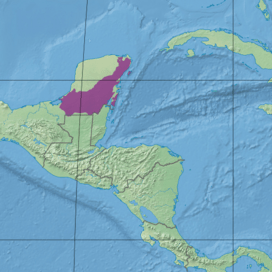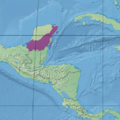Yucatán moist forests facts for kids
Quick facts for kids Yucatán moist forests |
|
|---|---|

|
|

Ecoregion territory (in purple)
|
|
| Ecology | |
| Realm | Neotropical |
| Biome | tropical and subtropical moist broadleaf forests |
| Borders |
List
|
| Geography | |
| Area | 69,849 km2 (26,969 sq mi) |
| Countries | southeastern Mexico, Guatemala and Belize |
| Conservation | |
| Conservation status | Vulnerable |
| Protected | 23.5% |
The Yucatán moist forests are a special type of forest area. They are part of the tropical and subtropical moist broadleaf forests biome, which means they are warm, wet forests with many trees that keep their leaves all year. The World Wildlife Fund describes them as an ecoregion, which is a large area of land or water that contains a distinct set of natural communities.
You can find these forests on the Yucatán Peninsula. This area is located in southern Mexico, northern Guatemala, and northern Belize.
Contents
Where are the Yucatán Moist Forests Located?
This ecoregion covers about 69,849 square kilometers (27,000 square miles). It is mostly flat land. The ground beneath much of the forest is made of porous limestone. This means water drains away quickly, so there are not many permanent rivers, even though the climate is humid.
To the northwest, these moist forests meet the drier Yucatán dry forests. To the south, they border the Petén–Veracruz moist forests.
What is the Climate Like in the Yucatán Moist Forests?
The Yucatán moist forests have a tropical and humid climate. This means it is generally warm and wet all year. The amount of rain each year is between 1,000 and 1,500 millimeters (39 to 59 inches). The northern parts usually get less rain, while the south and east get more.
Rainfall changes with the seasons. August and September are typically the driest months in this region.
What Plants Grow in the Yucatán Moist Forests?
The most common plant types here are tall and medium semi-evergreen forests. The trees in these forests form a canopy, which is like a roof of leaves, 20 to 35 meters (65 to 115 feet) high. About 25% to 50% of these trees lose their leaves during the dry season each year.
- Manilkara zapota is the most common tree. It is known for its sweet fruit and sap.
- Other trees include Brosimum alicastrum, Pimenta dioica, Lonchocarpus castilloi, Pouteria campechiana, Swietenia macrophylla, Alseis yucatanensis, Zuelania guidonia, Cedrela odorata, Swartzia cubensis, Orbignya cohune, Aspidosperma desmanthum, and Aspidosperma megalocarpon.
Plants in Flooded Areas
In areas that flood seasonally, known as bajos, you find low flooded semi-evergreen forests. The canopy here is shorter, only 8 to 10 meters (26 to 33 feet) high. About half of these trees also lose their leaves during the dry season.
- Common trees in these wet areas include Cameraria latifolia, Vachellia pringlei, Dalbergia glabra, Pisonia aculeata, Pithecellobium dulce, Pseudophoenix sargentii, Haematoxylon campechianum, and Acoelorrhaphe wrightii.
- You will also see many ferns and epiphytes, which are plants that grow on other plants.
What Animals Live in the Yucatán Moist Forests?
This ecoregion is home to many different animals, from large mammals to unique birds.
Large Mammals
Several large plant-eating mammals live here:
- Central American tapir (Tapirus bairdii)
- White-lipped peccary (Tayassu pecari)
- Collared peccary (Dicotyles tajacu)
- White-tailed deer (Odocoileus virginianus)
- Yucatan brown brocket deer (Mazama pandora)
- Central American red brocket deer (Mazama temama)
Wild Cats
Five different species of wild cats, called felids, roam these forests:
- Jaguar (Panthera onca)
- Puma (Puma concolor)
- Ocelot (Leopardus pardalis)
- Jaguarundi (Herpailurus yagouaroundi)
- Margay (Leopardus wiedii)
Primates
Two types of native monkeys live in the trees:
- Yucatan spider monkey (Ateles geoffroyi yucatanensis)
- Guatemalan black howler (Alouatta pigra)
Unique Birds
Many birds are endemic to the Yucatán region, meaning they are found only here. Some of these include:
- Ocellated turkey (Meleagris ocellata)
- Yucatan nightjar (Antrostomus badius)
- Yucatán woodpecker (Melanerpes pygmaeus)
- Yucatan poorwill (Nyctiphrynus yucatanicus)
- Yellow-lored parrot (Amazona xantholora)
- Yucatan flycatcher (Myiarchis yucatanensis)
- Yucatan jay (Cyanocorax yucatanicus)
- Rose-throated tanager (Piranga roseogularis)
- Orange oriole (Icterus auratus)
Three bird species are found only on Cozumel Island, which is part of this ecoregion:
- Cozumel emerald (Chlorostilbon forficatus)
- Cozumel vireo (Vireo bairdi)
- Cozumel thrasher (Toxostoma guttatum)
Why is Conservation Important for the Yucatán Moist Forests?
Even though some parts of the Yucatán moist forests are protected, the ecoregion faces threats. The main dangers come from logging, which is cutting down trees, and cattle farming, which clears land for cows. These activities can harm the delicate balance of the forest ecosystem.
Protected Areas
About 23.5% of this ecoregion is part of protected areas. These special places help keep the forests and their wildlife safe. Some of these protected areas include:
- Sian Ka'an Biosphere Reserve
- Tulum National Park
- Ría Lagartos Biosphere Reserve
- Laguna de Términos Flora and Fauna Protection Area
- Uaymil Flora and Fauna Protection Area
- Yum Balam Flora and Fauna Protection Area
- Balam-Kin
- El Zapotal Voluntary Conservation Area
Images for kids
-
Forests surrounding the ancient Maya city of Cobá in the northeast of the Yucatán peninsula.
See also

- Bosques húmedos de Yucatán para niños
- List of ecoregions in Mexico



